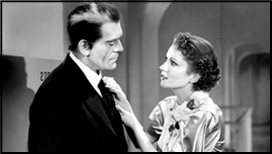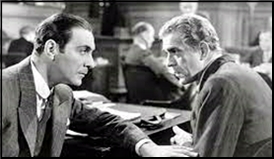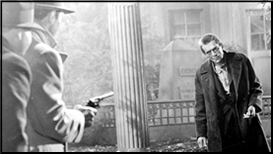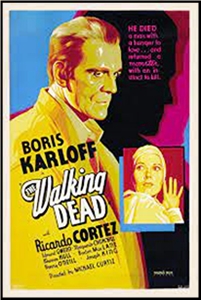October 2015
Monthly Archive
Tue 27 Oct 2015
Reviewed by JONATHAN LEWIS:

THE WALKING DEAD. Warner Brothers, 1936. Boris Karloff, Ricardo Cortez, Edmund Gwenn, Marguerite Churchill, Warren Hull, Barton MacLane. Director: Michael Curtiz.
If you haven’t yet seen The Walking Dead, do so. You’re in for a real treat. But I don’t mean the AMC television show. No, I mean the taut programmer directed by famed Warner Brothers director Michael Curtiz. Starring the legendary Boris Karloff, this proto-noir thriller squeezes in melodrama, social commentary, and suspense in a running time just over an hour long. All that, and some beautifully filmed camera shots at unsettling angles and an economical use of light and shadow to convey meaning.

The plot isn’t all that inventive. Karloff portrays John Ellman, an ex-con and general all around sad sack, who gets framed for the murder of the judge who put him in the slammer in the first place. Making matters even worse for the music-loving and piano-playing Ellman is the fact that his serpentine lawyer (Ricardo Cortez) is in bed with the very racketeers who framed him. Ellman’s sentenced to the chair and despite some last minute attempts to stay the execution, gets put to death.

Or does he? Enter the bespectacled foreign scientist, one Dr. Beaumont (Edmund Gwenn) who brings – you guessed it – Ellman back to life.
Although he’s alive again, there’s something just not quite right about Ellman. Maybe he is beholden to supernatural forces from beyond the grave. Whatever the case may be, it’s not long until Ellman exacts revenge on the men who unjustly sentenced him to death. Blending horror with social realism, The Walking Dead is an effective thriller that’s well worth your time.
Mon 26 Oct 2015
Posted by Steve under
Reviews[11] Comments
REVIEWED BY DAN STUMPF:

JEAN RAY – Malpertuis. Les Auteurs Associés, Bruxelles, 1943. Atlas Press Edition, 1998, translated by Iain White. Reprinted many times in French. Film: Malpertuis. Belgium, 1971; released in the US as The Legend of Doom House; directed by Harry Kümel, and starring Orson Welles, Susan Hampshire and Mathieu Carrière.
This may be the high point of my Halloween reading this year, an intelligent, compassionate and eminently creepy book of highly unusual character.
Malertuis (the title translates to “House of the Fox,†“House of Evil,†or “House of the Devilâ€; you pays your money and you takes your choice.) starts off in the classic mode with the story set in a narrative framework, introduced by a professional burglar:
“In the course of my career I have made a close study of the sound of footsteps heard in sleeping households—in much the same way as detectives have studied the ashes of pipes and cigars.â€

… who looted a monastery and found among the pricey relics a bunch of papers which he has correlated into the story we are about to read, as told by different players in the drama at different times.
We start off with a quick snippet of pirates on a dicey mission at the far corners of the known world — the sort of thing Jack Sparrow might get into — then shift to who-knows-how-many years later, in an unnamed French city where the son of a pirate captain, a young man named Jean-Jacques, is summoned to Malpertuis, the home of his dying uncle, along with the rest of his relatives, to hear the particulars of his uncle’s will.
This has been used as the set-up for countless Old Dark House thrillers, as has the ensuing codicil, which specifies that the claimants must reside in the house to inherit its fabulous wealth; one can almost see the grasping nebbishes being picked off one by one by some hooded phantom, or perhaps a killer ape; one never knows.

This, however, is no ordinary assortment of relatives and Malpertuis proves to be a much different sort of abode than one might expect, even in a horror novel, as Jean-Jacques interacts with his sister, his aunts, and a beautiful cousin who loves him possessively but will never look at him. There are also miscellaneous hangers-on: a madman who haunts the halls crying for light, and unseen spirit that blows out candles as it moves through the house:
“A hand pinched the wick and night flowed down the staircase like the waters of Hell.â€
… and assorted lovers who come to grisly ends, and then are never spoken of.
Author Ray moves his tale gracefully from the monstrous to the metaphysical as Jean-Jacques seeks spiritual rescue from the forces that impute his fall to from grace, but this is no mere battle against the powers of Darkness; Ray uses the horror novel as a means of examining the very nature of theology and man’s relationship to whatever gods may be. And he does it with suspense, beauty and a hugely satisfying conclusion.
Mon 26 Oct 2015
THE BACKWARD REVIEWER
William F. Deeck

BRANDON BIRD – Downbeat for a Dirge. Dodd Mead, hardcover, 1952. Detective Book Club, hardcover reprint, 3-in-1 edition. Also published as: Dead and Gone: Dell 857, paperback, 1955.
While the sublettor of the apartment under Hampton Hume’s is with Hume and his wife, the woman rehearsing a song is murdered in a room below. During the wait for the police, the woman’s body is removed, presumably by the murderer, and an attempt is made to clean up the room.
The murdered singer was a chanteuse, if there can be such a thing with a band playing Music Out of Dixie. A magazine illustrator and a former musician, Hume, who had appeared in two earlier novels, joins the band at police request when the band’s saxophonist disappears.
If I relate my problems with the plot, it will give away essential information. So I’ll just say there were no more Hamp Hume mysteries after this one, no loss to the world of fiction.
The Hampton Hume series ––
Death in Four Colors. Dodd Mead, 1950.
Never Wake a Dead Man. Dodd Mead, 1950.
Downbeat for a Dirge. Dodd Mead, 1952.
Note: A fourth book by Brandon Bird, Hawk Watch (Dodd Mead, 1954), not in the Hume series, was reviewed earlier on this blog by Walter Albert. You can read his comments here, along with considerable biographical information about the authors: George Bird Evans, (1906-1998) & Kay Harris Evans, (1906-2007). Some discussion of a fifth book they wrote, The Pink Carrera (Dodd Mead, 1960), as by Harris Evans, is also included in Walter’s post.
Sun 25 Oct 2015

MIMIC. Miramax, 1997. Mira Sorvino, Jeremy Northam, Alexander Goodwin, Giancarlo Giannini, Charles S. Dutton, Josh Brolin, Alix Koromzay, F. Murray Abraham. Based on the short story “Mimic,” by Donald A. Wollheim (Astonishing Stories, December 1942). Director: Guillermo del Toro.
The basic plot is simple enough. A laboratory-created insect called the Judas breed is developed to kill off a city filled with cockroaches which are spreading a deadly disease primarily affecting children. Even though the new insects were specifically designed to die out within a single generation, you can guess what comes next.

The reason both the story and the film is titled “Mimic,” is because the new insect creatures have developed by rapid evolutionary means a way of avoiding detection — and that is by outwardly mimicking their number one predator, humans.
Not everyone in the cast makes it out of the movie alive, qualifying it as more of a horror film than a science-fictional one. Gorgeously if not sumptuously filmed, including plenty of small details, it’s a scary film, too — until, that is, the human-shaped insectoids actually appear on the screen. They’re ugly enough all right, but not nearly as fearsome as the anticipation.

There are plenty of plot holes, too, which I needn’t go into, I suppose, as only someone such as myself who prefers story lines that make sense would care.
Me, though, I wished that as much attention were made to the story line as was paid to the cinematography and special effects. It’s one of those movies that you have to decide to sit back and watch, without asking too many questions, hoping things will sort themselves out later. A second watching may answer some of the questions I had, but as for me, the one ride is the only ride I’m going to take.
Sun 25 Oct 2015
Reviewed by JONATHAN LEWIS:

BILLY THE KID VS. DRACULA. Embassy Pictures, 1966. John Carradine (Count Dracula), Chuck Courtney (William ‘Billy the Kid’ Bonney, Melinda Plowman, Virginia Christine, Harry Carey Jr., Walter Janowitz, Bing Russell. Director: William Beaudine.
Fans of hybrid Westerns/vampire B-movies rejoice! For Billy The Kid vs. Dracula has all the elements one might expect in a film with such a captivating title. Things like clumsy dialogue and acting, silly special effects, and a plot just formulaic enough that almost works. But most importantly, Billy The Kid vs. Dracula has John Carradine in it.

Now, if you’re not a fan of Carradine and don’t particularly care for his unique gait and voice, this obscure low-budget production definitely isn’t for you. If you are like me and happen to appreciate Carradine (all the while knowing he appeared in some truly dismal features), then you might appreciate how much he towers, both literally and figuratively, over all the other actors in the otherwise forgettable film. His portrayal of a vampire lurking about in the Old West is both campy and creepy. Although I am hardly a specialist on horror Westerns, I dare say there’s really nothing quite like it out there in any movie before or since.
More than anything else, the movie’s premise is so absurd that it almost makes this ludicrous experiment in genre-bending a cult classic, one of those bad horror movies that’s so bad that it’s actually good. Almost being the key word.
Sat 24 Oct 2015
THOMAS B. DEWEY – Nude in Nevada. Dell 6508, paperback original; 1st printing, April 1965.

I’ve read one or two of Dewey’s PI Pete Schofield novels, but I don’t remember it (or both) being as lackluster as this one is. It starts out poorly, as far as I was concerned, and never gets any better as it goes along. It does have some good moments, though, enough to keep me hoping, and I ended up finishing it. With another author, less known to me, I probably wouldn’t have.
Pete Schofield is one of the few tough PI’s of the 50s and 60s era who happened to be married, and happily so. It did cut down on his womanizing, though that never seemed to stop him from looking. In any case, as the books begins, Pete and Jeannie are driving somewhere through the Nevadan desert when their car breaks down, miles from anywhere.
Or so he thinks at first. Then he remembers that by pure chance an old friend, Strangler Martin, just happens to own a small garage and poor man’s resort a few miles back and off the road a way. He and Jeannie hoof it there, only to find Martin and his wife being held prisoner of a gang of foreigners whose language Pete doesn’t recognize. Perfect timing. What are the odds?
The gang has killed the cook, so obviously they mean business. Also a prisoner is a young lady who is completely naked but covered with tattoos, and when Pete and Strangler Martin manage scare off the bad guys (this really puzzled me, how they managed to pull this off) the lady is happy to have them take a closer look.
Then adding to the absolute weirdness of the evening, a horde of soldiers from a nearby army base stops by, and a party breaks out. A case might be made that this was meant to be a screwball mystery, but to me, it doesn’t make any more sense now when I’m telling you this than when I was reading it. As I said earlier, I was hoping Dewey could go somewhere with this wacky beginning, but other than morphing into a long and uninteresting story of international espionage, as far as I am concerned, he never did.
Otherwise all ends well, but since this is last recorded adventure of the Schofields, I’m afraid we’ll never know where Jeannie wants to get a tattoo, or in fact if she ever did.
The Pete Schofield series —
And Where She Stops. Popular Library, 1957.
Go to Sleep, Jeannie. Popular Library, 1959.
Too Hot for Hawaii. Popular Library 1960.
The Golden Hooligan. Dell, 1961.
Go, Honeylou. Dell, 1962.
The Girl with the Sweet Plump Knees. Dell, 1963.
The Girl in the Punchbowl. Dell, 1964.
Only on Tuesdays. Dell, 1964.
Nude in Nevada. Dell, 1965.
Sat 24 Oct 2015
Reviewed by DAVID VINEYARD:

CEMETERY MAN. Italy-France-Germany, 1994. Original title: Dellamorte Dellamore. Released in the US in 1996. Rupert Everett, François Hadji-Lazaro, Anna Falchi, Mickey Knox. Screenplay by Gianni Romoli, based on the novel by Tiziario Sclavi. Directed by Michele Soavi.
Dellamorte means ‘of death’ and dellamore means ‘of love,’ and more than that I can’t really rationally explain about this sexy, arty, off the wall Italian horror film about love, passion, duty, friendship, and, of course, zombies.
Francesco Dellamore (Rupert Everett) keeps the cemetery in Buffalora in Italy, which is more of a job than you might think, since every seven days the dead rise and he has to put a bullet in their brains and return them to their grave (no explanation is ever given and absolutely no one seems the least concerned with this curious arrangement) with the help of gentle mute giant grave-digger Gnagi (François Hadji-Lazaro). Dellamore is a handsome young man, and by now rather bored with his job and living by the decidedly creepy old town cemetery, but lacks the motivation to move on until She (billed only as She in the credits) shows up, Anna Falchi, whose husband recently died.

Dellamore and the widow make love on the husband’s grave after which the husband rises and bites her. When she dies and comes back, Dellamore kills her again, but by now he wants away from this life and the gentle Gnagi has fallen in love with the daughter of the mayor. Some other complications ensue, including a Viagra moment for our hero, and with Dellamore seeing the woman he killed everywhere, the two men flee but their journey comes to an abrupt end with Gnagi supposedly dead. Dellamore can’t bring himself to kill his friend, but Gnagi wakes up, not having died, and the film ends as he throws Dellamore’s gun into an abyss as snow swirls around them and the two friends apparently choose to abandon zombie-killing and babysitting the dead as a chosen profession.

This film is strange by any lights, informed by everything from giallo films to Italian adult digest sized horror comics, American road trip movies, and the offbeat philosophy of the author of the novel this is based on. What I can say about it is that it is curiously compelling with good performances by Everett, Falchi, and Hadji-Lazaro; creepy if never actually all that scary, sexy (and be warned there is full frontal nudity), and sweet and funny — for a zombie film.
Imagine Fellini crossed with Mario Bavo or Dario Argento, add sexually graphic de Sadean Italian digest-sized horror and gothic fumetti like Isabella and Ullua (a female werewolf), a bit of Jesus Franco, throw in some zombies and explicit nudity and sex and you have Cemetery Man.

Which is actually better than it sounds, if not a lot more sensible.
Everett shows an ease on screen that belies his relative youth in this early film and commands the film, which is just as well since he is in most scenes, and Hadji-Lazaro proves a unique blend of endearing, creepy, sweet, and threatening as Gnagi, at times channeling Curly of the Three Stooges, whom he resembles a bit with a face at once sweetly innocent and somehow potentially threatening. Falchi’s role is thankless, but she is attractive and sexy and worth seeing nude. And while the film never really manages any scares or much in the way of gross-out terror or other horror film staples, it is often quirkily funny, thanks to the Laurel and Hardy routine between Everett and Hadji-Lazaro, good for a few frissons, and hard not to watch.

I can’t really recommend this for anyone else. If anyone hates it, I have no problem with that either. It worked as a strangely compelling and twisted little film for me with attractive adults having sex (a step up from most American horror films with supposed teens dying because they did the nasty), a truly odd couple team-up, and, not to forget, zombies. Curiously I think that was exactly what it was intended to do and that it succeeds as what it was meant to be.
I’m just not entirely sure what it was meant to be that it succeeds at doing so well, or that it really matters if I ever know.
Sat 24 Oct 2015
THE CURRENT TV SEASON
by Michael Shonk
Some notes of interest for the Mystery*File TV viewer.
CW – Since all programs are made by the studios that own the network (CBS and Warner Brothers) CW is slow to cancel. Only REIGN is in any trouble.
ABC – BLOOD AND OIL will end after 10th episode. QUANTICO has been picked up for a full season. NASHVILLE is in trouble as usual, but CASTLE is in danger due to its age and having its butt kicked by NBC’s BLINDSPOT. WICKED CITY, a series about a serial killer in 1982 Los Angeles, premieres Tuesday the 27th.
CBS – LIMITLESS has been picked up for a full season. CSI: CYBER is doomed. NCIS:LA is in trouble for the same reason as CASTLE (NBC’s BLINDSPOT).
FOX – MINORITY REPORT is gone after its tenth episode. ROSEWOOD has been picked up for a full season. SLEEPY HOLLOW, BONES and any sitcom are in trouble.
NBC – BLINDSPOT has been picked up for the season. THE PLAYER ends in mid-November. The network’s biggest problems are its sitcoms and its suicidal handling of THE BLACKLIST.
PBS – BBC’s SHERLOCK returns with a one episode special. “The Abominable Bride†will air January 1st.
Starz – DA VINCI’S DEMONS has just began it last season.
Midseason will be here before you know it.
Thu 22 Oct 2015

B.A.D. CATS. “Pilot episode.” ABC-TV, 90m, 4 January 1980. (Season 1, Episode 1). Asher Brauner (Officer Nick Donovan), Steve Hanks (Officer Ocee James), Michelle Pfeiffer (Samantha ‘Sunshine’ Jensen), Vic Morrow (Capt. Eugene Nathan). Guest cast: LaWanda Page, Jimmie Walker, Charles Cioffi. Producer: Aaron Spelling.
According to Wikipedia, the acronym B.A.D Cats stood for “Burglary Auto Detail, Commercial Auto Thefts.” Now that’s nice to know, since after watching this pilot episode, I couldn’t have told you. I might have missed it, but other hand, I was deliberately looking and listening, and I really don’t think it ever came up.
But I admit I may have snoozed off. This is a TV show that makes you wonder why some shows ever manage get on the air. It is Not Very Good. It lasted six episodes before being deep-sixed, with four more ready to go and never aired.

It is a wonder, though, that with very young Michelle Pfeiffer in it as the handy girl around the office, answering phones and looking pretty and the like, that no one has come out with an official set of DVDs for the series. Perhaps she has a good lawyer.

This first episode has to do with a gang of crooks trying to smuggle a fortune of gold out of the country, and do to so they come up with a plan that involves faking the cops out by stealing a fleet of high-priced automobiles and shipping them overseas, while they are really…
The fact that Jimmie Walker is in this as an inveterate car thief tells you right away that the story is played as much for laughs as anything else, along with one of the two stars’ infatuation with a water bed, with a worried downstairs lady neighbor who thinks the floor will give way. I don’t think it gives anything away to say that it does, to the hilarity of all.
What should you expect to see otherwise? Lots of long car chases, that you bet your bottom dollar on. The last one I will concede is a doozy, but I should also warn you that it takes a long time to get there.
Thu 22 Oct 2015
REVIEWED BY BARRY GARDNER:

A. E. MAXWELL – The King of Nothing. Fiddler & Fiora #7. Villard, hardcover, 1992. Harper, paperback, 1994.
The “A. E.” stands for Ann and Evan, who are the husband and wife who together write the Fiddler books, and have written several others besides. Their characters are no longer husband and wife, but lovers still. Fiddler is wealthy, by somewhat shady means detailed in the first book in the series; Fiora is wealthier, by virtue of being a financial wheeler-dealer and entrepreneur. You might, without stretching things too far, look at them as a West Coast McGee and Meyer with a little sex and a lot of money thrown in.
Which is not to say that the Maxwells together are another John D. MacDonald, because they aren’t. They do combine to write very good prose, however, and I have thought highly of the series to date.

In the latest episode, Fiddler is fishing with an old friend at his place on the coast of Washington. One day the friend makes Fiddler aware that he is to be the executor of his estate, and the recipient of an old Samurai sword, a souvenir of war experiences. The next day the friend is found dead, apparently the victim of a break-in and robbery. The local police do not inspire Fiddler with confidence. Concurrently, Fiora has been in Seattle negotiating with a Japanese conglomerate to sell her financial firm.
Aha, Samurai sword, Japanese firm — can there be a connection? Well, maybe. Several gory deaths later you find out.
This wasn’t my favorite of the series, and I’m really not sure why. The plot was a tad far-fetched in places, but most books of this type suffer from that. The writing was competent as usual, and Fiddler and Fiora continue to be engaging characters. At one time I was afraid they were headed toward some of Robert B. Parker’s Spenser-Susan kind of foolishness, but the Maxwells seem to have drawn back in time.
Oh well, some you like more than others, some less. Still recommended, as are the first six in the series.
— Reprinted from Fireman, Fireman, Save My Books #3, September 1992.
The Fiddler and Fiora series —
1. Just Another Day in Paradise (1985)
2. The Frog and the Scorpion (1986)
3. Gatsby’s Vinyard (1987)
4. Just Enough Light to Kill (1988)
5. The Art of Survival (1989)
6. Money Burns (1991)
7. The King of Nothing (1992)
8. Murder Hurts (1993)
« Previous Page — Next Page »



